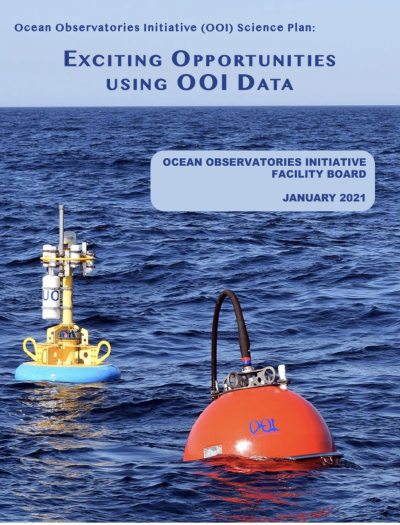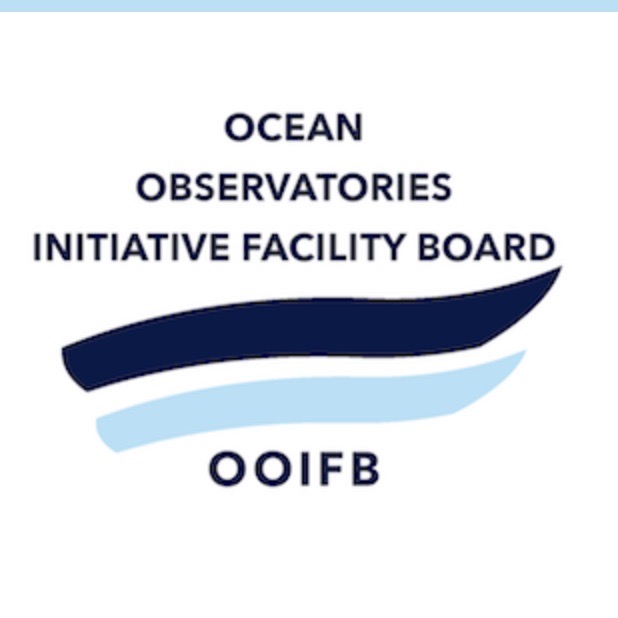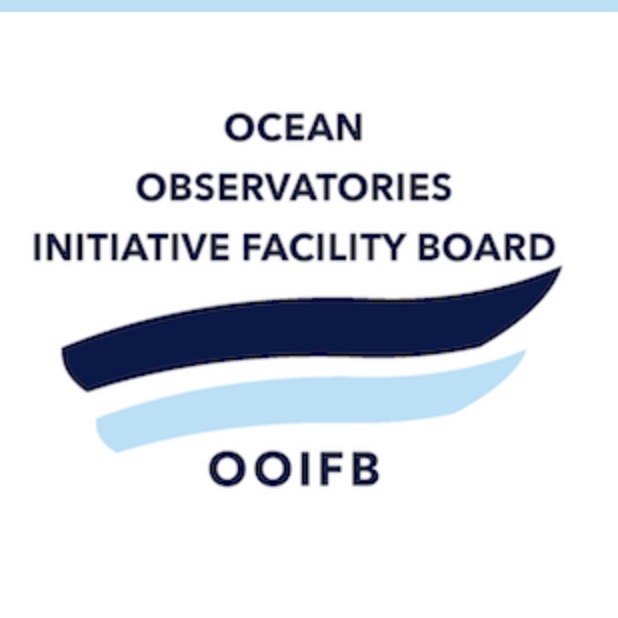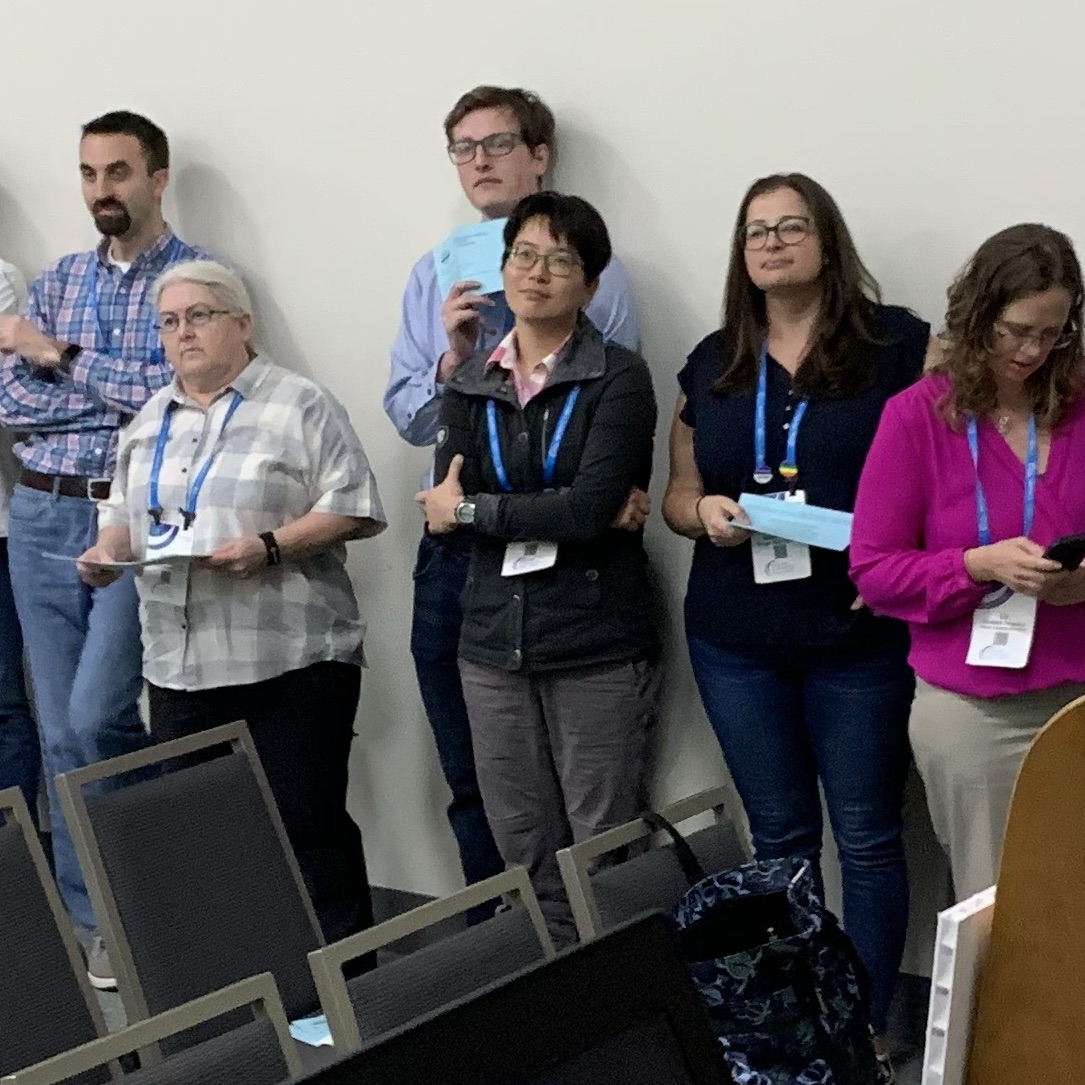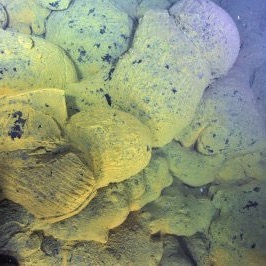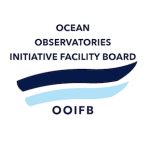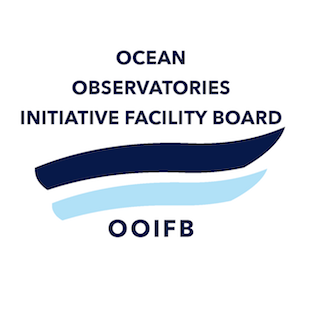Posts Tagged ‘OOIFB’
New OOI Science Plan Now Available
The Ocean Observatories Initiative (OOI) Science Plan: Exciting Opportunities Using OOI Data is now available. This OOI Science Plan articulates the exciting research, educational opportunities, and pathways to advancing the understanding of high-priority science questions using OOI data. Specifically, the Plan is intended to inspire and enable the research endeavors of ocean scientists and educators, encourage collaborations, and motivate the training of future generations of scientists.
The document highlights the broad science themes and provides examples of important multidisciplinary science questions that require the OOI’s novel technology. Sidebars from scientists using OOI data illustrate the novel approaches being used to address long-standing science questions that are hard to address using ship-based expeditionary practices. The Science Plan includes a high-level synopsis of the current ocean network, the OOI program management, and data quality control and delivery. Innovative platforms and technologies are highlighted, as well as best practices developed by the OOI program. The Plan includes examples of educational opportunities and new applications provided by OOI data and ocean observing concepts. Community Engagement activities promoted by the OOI are featured. The document describes the ways in which current U.S. interagency partnerships and international collaborations make use of the OOI network in unique ways. Finally, information on how scientists and educators can participate in the OOI is provided.
The OOI Science Plan is available on the OOIFB website here.
For those preparing applications for the Pioneer Array Innovations Lab, this Science Plan could be a useful resource.
Read MoreJanuary 31 Deadline for Applications to Consider Pioneer Array Relocation
Apply to select the next location of the OOI Pioneer Array
Applications are due on January 31st!
The Ocean Observatories Initiative Facilities Board (OOIFB) and the National Science Foundation (NSF) have launched a process to consider whether to move the Pioneer Array from its current location, on the New England shelf and slope south of Martha’s Vineyard, to a new location. Selection of the next OOI Pioneer Array location, or decision to maintain the Array at its current location, will be driven by community input on the important science questions that can be addressed by the Pioneer Array.
The OOI community is invited to weigh in on this important decision during a two-phase sequential lab approach that will bring scientists, educators, and other stakeholders together virtually to evaluate 1) future location options for the Pioneer Array and 2) new design considerations that can enable exciting research endeavors at the chosen location.
Two Innovations Labs will be held in 2021. The Phase 1 Innovations Lab, March 15-19, will explore possible locations for the Pioneer Array based on scientific questions that require an ocean observatory to advance knowledge. At the Lab, interdisciplinary teams will work together to ideate and develop a roadmap of possible locations including exploring new scientific, educational, and partnership opportunities.
The Phase 2 Innovations Lab, in late spring/early summer, will come up with a plan to maximize the science gains and broader impacts of the potential new site. If a new site is recommended, the Array would be moved in 2023.
How to become involved
For those interested in learning more, please visit the OOIFB webpage regarding the Pioneer Array location selection process. The webpage includes a link to the application form to participate in the Phase 1 Innovations Lab. The application deadline is 31 January 2021. Selected Innovations Lab participants will be announced in mid-February.
More information or to apply, please visit here.
Read MoreShould the Pioneer Array be moved? If so, where?
In 2021, the Ocean Observatories Initiative Facilities Board (OOIFB) and the National Science Foundation (NSF) are launching a process to consider whether to move the Pioneer Array from its current location, on the New England shelf and slope south of Martha’s Vineyard, to a new site. Selection of the next OOI Pioneer Array location, or decision to maintain the Array at its current location, will be driven by community input on the important science questions that can be addressed by the Pioneer Array.
The OOI community is invited to weigh in on this important decision during a two-phase sequential lab approach that will bring scientists, educators, and other stakeholders together virtually to evaluate 1) future location options for the Pioneer Array and 2) new design considerations that can enable exciting research endeavors at the chosen location.
Two Innovations Labs will be held in 2021. The Phase 1 Innovations Lab, March 15-19, will explore possible locations for the Pioneer Array based on multiple factors, driven by scientific questions that require an ocean observatory to advance knowledge. At the Lab, interdisciplinary teams will work together to ideate and develop a roadmap of possible locations including exploring new scientific, educational, and partnership opportunities.
The Phase 2 Innovations Lab, in late spring/early summer, will come up with a plan to maximize the science gains and broader impacts of the potential new site. If a new site is recommended, the Array would be moved in 2023. The OOI Coastal and Global Scale Nodes (CGSN) Team at Woods Hole Oceanographic Institution would continue the operation and maintenance of the array, regardless of its location.
The Lab’s findings will be considered by an NSF review panel, which will report to NSF in early fall on the new Pioneer Array location and how it can be optimized for science and education.
How to Become Involved
For those interested in learning more, a 60-90-minute informational session, Phase 1 Micro Lab, is planned for 13 January 2021, beginning at 1 pm Eastern. Representatives from NSF along with CGSN, the current operator of the Pioneer Array, will present information about the selection process and technical details about the Pioneer Array.
Individuals interested in applying for the Phase I Innovations Lab are encouraged to attend the Micro Lab. The information provided could be useful in submitting an application. To attend the Phase 1 Micro Lab, please RSVP here.
The application to participate in the Phase 1 Innovations Lab is available here. The application deadline is 31 January 2021.
Selected Innovative Lab participants will be announced in mid-February. Participants selected for Phase I will also be considered for Phase II.
What to Expect
The Innovations Labs will bring together scientists, stakeholders, and educators. Interdisciplinary teams will work together for six-hour days for the full week. Teams will form, pitch, and refine plans (based on input from experts and other participants). Participants will meet virtually each day of the week (M-F). Four days will be for synchronous meetings and one day will be dedicated to asynchronous team work
To learn more or to apply, click here.
Read More
Passing of Dr. Larry Atkinson
[caption id="attachment_20086" align="alignleft" width="240"]
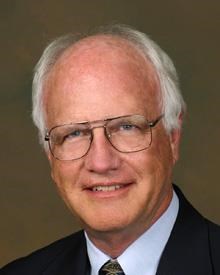 Larry P. Atkinson[/caption]
Larry P. Atkinson[/caption]
The OOI Team notes with great sadness the passing of Dr. Larry Atkinson on December 22nd, 2020. Larry was Eminent Scholar Emeritus and Professor Emeritus of Ocean, Earth and Atmospheric Sciences in the Department of Ocean, Earth and Atmospheric Sciences and the Center for Coastal Physical Oceanography at Old Dominion University. In addition to significant contributions to oceanographic research and education throughout a distinguished career at a number of institutions, Larry served for many years as Chair and then Past Chair of the OOI Facilities Board (OOIFB), which provides independent input and guidance regarding the management and operation of the OOI to the National Science Foundation.
Throughout his many years of service on the OOIFB, Larry provided valuable advice and consistent encouragement as the program was being implemented and developed. In 2020, in recognition of his many contributions, the OOIFB established the Larry P. Atkinson Travel Fellowship for Students and Early Career Scientists, which will enable students and scientists from across the globe to meet and advance the understanding of the ocean. Larry will be greatly missed by those members of the OOI Team who worked closely with him, and by the many more who were influenced and impacted by his steadfast wisdom and support.
Larry’s obituary can be read here.
Read MoreOOIFB Town Hall 8 Dec, Includes Lightning Talks
The Ocean Observatories Initiative Facilities Board (OOIFB) will host a Town Hall during the virtual 2020 Fall AGU meeting. The Town Hall is scheduled for Tuesday, December 8th from 10:00 am to 11:00 am EST. The community will have the opportunity to hear the latest information about the OOI facility, meet the OOIFB members, and learn about research using OOI data. The new OOI Data Explorer tool will be demonstrated, the exciting activities of OOI education programs will be featured, and early career scientist activities will be highlighted.
The Town Hall is aimed at researchers who are now using or are considering using OOI data, researchers interested in adding instrumentation to the OOI infrastructure, and educators at all levels interested in the OOI. Lightning talks will be presented during the Town Hall, as well as at OOI’s virtual booth on Thursday 10 December from 6-7 pm. For those interested in the Thursday presentation, join the discussion here.
Event: OOI Facility Board Town Hall
When: Tuesday, December 8th from 10:00 am to 11:00 am EST (7:00 am to 8:00 am Pacific)
Additional Details: https://ooifb.org/meetings/2020-agu-meeting-ooifb-town-hall/
Town Hall Agenda
1000 Welcome, Introductions, Activity Update – Kendra Daly (USF), OOIFB Chair
1005 Updates from the National Science Foundation – Lisa Clough (NSF)
1015 Updates from the OOI Operator – John Trowbridge (WHOI)
1020 OOI Date Explorer Demo – Brian Stone (Axiom)
1025 OOI Education Data Labs Report – Janice McDonnell (Rutgers U)
1030 OOI Activities initiatives by Early Career Scientists – Sophie Clayton (ODU)
1035 Lightning Talk Presentations
1055 Questions, Answers, and Discussion
1100 End of Town Hall
Lightning Talk Presenters
Shima Abadi, University of Washington
Bill Chadwick Oregon State University
Bill Davis, BeachNecessities.com
Rachel Eveleth, Oberlin College
Erik Fredrickson, University of Washington, School of Oceanography
Natalie Freeman, University of Colorado Boulder
Matthew Lobo, Portland State University
Aaron Mau, University of South Carolina
Chris Russoniello, West Virginia University
William Wilcock, University of Washington
Guangyu Xu, Applied Physics Laboratory, University of Washington
Read More
Fifteen Findings in 15 minutes
“Just like lightning,” in one-minute presentations, 15 scientists shared amazing ways they are using OOI data in scientific investigations and in the classroom. This round of lightning talks capped the Ocean Observatories Initiative Facility Board’s (OOIFB) Town Hall at the 2020 Ocean Sciences Meeting on 20 February, demonstrating the multiple and creative ways OOI data are being used to answer key science questions in a changing environment.
The presentations ranged from how students are using real-life and real-time OOI data to advance their understanding of scientific principles to how researchers are using OOI data to identify the presence of marine life by sound to how modelers are making OOI data more accessible and useable.
“We were simply thrilled by the depth, breadth, and range of applications of OOI data shown during this lightning round,” Kendra Daly, chair of the OOIFB. “We were pleased so many presenters were willing to accept the challenge. This enthusiastic response clearly shows that OOI data are being used to help answer important science questions.”
Brief summaries of the talks are presented below.
Advancing science
Isabela Le Bras, Scripps Institution of Oceanography, reported on a recent article in Geophysical Research Letters, where she and her colleagues describe how they used data from the Irminger Sea Array moorings (2014–2016) to identify two water masses formed by convection and showing that they have different rates of export in the western boundary current. Upper Irminger Sea Intermediate Water appears to form near the boundary current and is exported rapidly within three months of its formation. Deep Irminger Sea Intermediate Water forms in the basin interior and is exported on longer time scales. The subduction of these waters into the boundary current is consistent with an eddy transport mechanism. The eddy transport process is more effective for the waters cooled near the boundary current, implying that cooling near boundary currents may be more important for the climate than has been appreciated to date.
Since 2017, Clare Reimers and Kristen Fogaren, Oregon State University, have been working to assess seasonal variability in benthic oxygen consumption and the contribution of benthic respiration to the development of hypoxic conditions in the northern California Current, using time series data from the OOI Endurance Array. Reimers and Fogaren measured benthic oxygen consumption rates using in situ eddy covariation techniques and ex situ core incubations, during a series of ten cruises that allowed sampling near the Endurance Oregon Shelf and Inshore stations, in all seasons. During these cruises, the researchers used real-time data provided by the Endurance Array to optimize the settings for their eddy covariance deployments. They are now examining property-relationships in discrete bottom water samples collected during the cruises and using data from OOI assets to help separate influences of mixing and biochemical processes in the water column and sediments. The researchers are also synthesizing benthic flux measurements and placing these rates in the context of cross-shelf glider measurements and benthic node time series.
Adrienne Silver, University of Massachusetts Dartmouth provided details about how she is using Pioneer Array data to learn more about the influence of warm core rings on Shelf break circulation. Results from a 40-year Warm Core Ring census show a regime shift in warm core ring formation at 2000, with the number of rings doubling from an average of 18 rings per year (during 1980-1999) to 33 rings per year (during 2000-2019). This regime shift creates a large increase in the amount of warm salty water being transported northward toward the shelf from the Gulf Stream. The preferred pathway of these rings, or the Ring Corridor seem to indicate their proximity to the shelf break and the Pioneer array during their lifetime. The goal of Silver’s project is to understand how these warm core rings affect the shelf break exchange while traveling along the shelf. A large focus of the study will be on the salinity intrusion events which might be sourced from these warm core rings.
Liz Ferguson, CEO and founder of Ocean Science Analytics, is using data from OOI’s Coastal Endurance and Regional Cabled Arrays to determine the variables that are most useful for assessing the ecosystem of this region and obtaining baseline information on marine mammal acoustic presence for use in monitoring. Using long term physical and biological data provided by these arrays, Ferguson is assessing long-standing shifts in the ecology of this coastal and offshore environment by associating physical oceanographic variables with the vocal presence of marine mammals using the broadband hydrophone data. Temporal changes in the occurrence of marine mammal species such as killer whales, sperm whales and dolphins can be used as an indicator of ecosystem shifts over time. She is analyzing passive acoustic data provided by the OOI arrays to determine the presence of vocally active marine mammal species, identify their spatial and temporal use of these sites, and combining this information with the physical oceanographic variables to assess the ecological characteristics associated with marine mammal occurrence.
Sam Urmy of the Monterey Bay Aquarium Research Institute (MBARI) also is using OOI acoustical data in his research. Using an upward-looking echosounder and a high-frequency hydrophone at MBARI’s Monterey Accelerated Research System, Urmy showed how small animals in the epipelagic and mesopelagic altered their behavior in response to predators. These responses included abrupt dives during bouts of foraging by dolphins, changes in depth to avoid predatory fish schools, and dramatic alterations to daily vertical migratory behavior. Continual observations of the mesopelagic with active and passive acoustics are revealing several dynamic predator-prey interactions in an ecosystem that is typically thought of as relatively slow and static.
Veronica Tamsitt of the University of New South Wales used the OOI’s Southern Ocean mooring and the Southern Ocean Flux Site (SOFS, in the Southeast Indian) to study the Sub Antarctic Mode water (SAMW) formation. Tamsitt’s and her colleagues findings were reported in the Journal of Climate in March 2020. Using data from the two mooring locations, the researchers were able to compare and contrast characteristics and variability of air-sea heat fluxes, mixed-layer depths, and SAMW formation. The researchers found that inter mixed-layer depth anomalies tended to be intermittent at the two moorings, where anomalously deep mixed layers were associated with anomalous advection of cold air from the south, and conversely shallow mixed layers correspond to warm air from the north. Both the winter heat flux and mixed-layer depth anomalies, however, showed a complex spatial pattern, with both positive and negative anomalies in both the Indian and Pacific basins that Tasmitt and colleagues relate to the leading modes of climate variability in the Southern Ocean.
Editor’s note: The Southern Ocean Array was decommissioned in January 2020. Its data, however, are still available for use by researchers, students, and the public.
Bringing OOI data into the classroom
Sage Lichtenwalner, Department of Marine and Coastal Sciences at Rutgers, The State University of New Jersey reported on the progress of the Ocean Data Labs Project. This project is a Rutgers-led effort to build a “Community of Practice” to tap into the firehose of OOI ocean data to support undergraduate education. To date, the project has hosted four “development” workshops that introduced participants to the OOI, conducted data processing with Python notebooks, and shared effective teaching strategies, in addition to a series of introductory workshops and webinars. As part of the development workshops, 56 university, college, and community college faculty designed 19 new “Data Explorations,” featuring web-based interactive “widgets” that allow students to interact with pre-selected data from the OOI. The project also sponsors a series of webinars, a fellowship program, and is compiling a library of resources (including coding notebooks, datasets, and case studies in teaching) to help the community.
Cheryl Greengrove, University of Washington Tacoma, summarized an article in the March issue of Oceanography that she and colleagues from across the United States wrote detailing ways to integrate OOI data into the undergraduate curriculum. The wealth of freely-accessible data provided by OOI platforms, many of which can be viewed in real or near-real time, provides an opportunity to bring these authentic data into undergraduate classrooms. The TOS article highlights existing educational resources derived from OOI data that are ready for other educators to incorporate into their own classrooms, as well as presents opportunities for new resources to be developed by the community. Examples of undergraduate introductory oceanography OOI data-based lessons using existing interactive online data widgets with curated OOI data on primary productivity, salinity, and tectonics and seamounts are presented, as well as ways to use OOI data to engage students in undergraduate research. The authors provide a synthesis of existing tools and resources as a practical how-to guide to support new resource development and invite other educators to develop and implement new educational resources based on OOI data.
Matthew Iacchei, Hawaiʻi Pacific University, presented how he has been integrating OOI data explorations to supplement his upper division oceanography lecture and labs with real data from around the world. Last semester, he had students explore patterns of dissolved oxygen and impacts of anoxia at the coastal endurance array in Oregon and compare that data to dissolved oxygen data the students collected in Kāneʻohe Bay, Hawaiʻi. This semester, students are working through two exercises with OOI data as part of their primary productivity lab (perfect, as it is now online!). Students will compare vertical profiles from Hawaiʻi with seasonal variations across the world, and will compare latitudinal drivers of primary production using data from a time-series from the Southern Ocean Array.
Strengthening OOI data usability
Wu-Jung Lee, a senior oceanographer at the Applied Physics Laboratory, University of Washington, is using data collected by the OOI to develop new methodologies for analyzing long-term ocean sonar time series. In a project funded by the National Science Foundation, she and her colleagues show that unsupervised matrix decomposition techniques are effective in discovering dominant patterns from large volumes of data, which can be used to describe changes in the sonar observation. Their preliminary analysis also show that the summaries provided by these methods facilitate direct comparison and interpretation with other ocean environmental parameters concurrently recorded by the OOI. A parallel effort that spun out of this project is an open-source software package echopype, which was created to enable interoperable and scalable processing of biological information from ocean sonar data.
As part of the Rutgers Ocean Modeling Group, in conjunction with University of California Santa Cruz, John Wilkin and Elias Hunter are delivering a high-resolution data assimilative ocean model analysis of the environs of the Pioneer Coastal Array, including a systematic evaluation of the information content of different elements of the observing network. The project uses the Regional Ocean Modeling System with 4-Dimensional Variational data assimilation. To produce a comprehensive multi-year (2014-2018) analysis required them to assimilate all available Pioneer CTD data, with quality checks, in a rolling sequence of data assimilation analysis intervals. They used three days of data in each analysis, which required queries to with a time range constraint and relevant platform (i.e. glider, profiler, fixed sensor), migrating all Pioneer CTD data (wire following profilers, gliders, fixed sensors, plus ADCP velocity) to an ERDDAP server. The simple graphing capabilities in ERDDAP allow quick browsing of the data to trace quality control or availability issues, and ERDDAP provides a robust back-end to other web services to create more sophisticated graphical views, or time series analysis. Using the ERDDAP Slide Sorter tool, they operate a quick look Control Panel to monitor the data availability and quality.
Mitchell Scott and colleagues Aaron Marburg and Bhuvan Malladihalli Shashidhara at the University of Washington, are studying how to segment macrofauna from the background environment using OOI data from the Regional Cabled Axial Seamount Array. Their long-term goal is to use an automated approach to study species variation over time, and against other environmental factors. Their initial step focuses specifically on scale worms, which are very camouflaged, making them difficult to detect. To address this, the researchers initially used a deep learning model, called U-Net, to detect and localize the scale worm locations within an image. To address the high rate of false positives using this model, they added an additional classifier (a VGG-16 model) to verify the presence of scaleworms. This combined, applied approach proved feasible for scale worm detection and localization. Yet because the environment of the Axial Seamount is so dynamic due to the growth and decay of chimneys at the site and resulting changes in bacteria and macrofauna present, they found the performance of the model decreased over time.
Weifeng (Gordon) Zhang of Woods Hole Oceanographic Institution has been using Pioneer Array data to understand the physical processes occurring at the Mid-Atlantic Bight shelf break, including the intrusion of Gulf Stream warm-core ring water onto the shelf and the ring-induced subduction of the biologically productive shelf water into the slope sea. His findings were reported in a Geophysical Research Letters paper where data from the Pioneer Array moorings and gliders demonstrated the anomalous intrusion of the warm and salty ring water onto the shelf and revealed the subsurface structure of the intrusion. Zhang also shared findings reported in the Journal of Geophysical Research: Oceans where data from the Pioneer Array showed a distinct pattern of relatively cold and fresh shelf water going underneath the intruding ring water. These results show the subduction of the shelf water into the slope sea and a pathway of shelf water exiting the shelf. In both instances, Zhang and his colleagues used computer modeling to study the dynamics of these water masses. These two studies together suggest that shelf break processes are complex and require more studies in the region.
Hilary Palevsky of Boston College presented results from an ongoing project funded by the National Science Foundation’s Chemical Oceanography program, using biogeochemical data from the OOI Irminger Sea Array. Analysis of dissolved oxygen data on OOI Irminger Sea gliders and moorings from 2014-2016 showed the importance of biogeochemical data collected over the full seasonal cycle and throughout the entire water column, due to the influence of subsurface respiration and deep winter convection on biological carbon sequestration. The OOI Irminger Sea array is the first source of such full-depth year-round data in the subpolar North Atlantic. To quantitatively evaluate the annual rate of carbon sequestration by the biological pump and the role of deep winter convection, Palevsky and colleague David Nicholson of the Woods Hole Oceanographic Institution collaborated with OOI to improve the calibration of oxygen data at the Irminger Sea array by modifying the configuration of glider oxygen sensors to enable calibration in air each time the glider surfaces, which improves the accuracy and utility of the data collected both from gliders and from moorings. Palevsky presented preliminary results demonstrating successful glider air calibration at the Irminger array in 2018-2019 as well as work by student Lucy Wanzer, Wellesley College, demonstrating the importance of well-calibrated oxygen time series data to determine interannual variability in rates of subsurface respiration and deep winter ventilation in the Irminger Sea.
Read More
OOI Facility Board Position Open; Application Deadline 20 March 2020
The Ocean Observatories Initiative Facility Board (OOIFB) is soliciting applications to fill one membership position that is currently open. Scientists with experience using scientific observing systems such as OOI are encouraged to apply.
The OOIFB was created in 2017 to provide independent input and guidance regarding the management and operation of the National Science Foundation-funded Ocean Observatories Initiative (OOI). The OOIFB provides a way to expand scientific and public awareness of OOI, and ensure that the oceanographic community is kept informed of developments of OOI.
The responsibilities of the OOIFB may include, but are not limited to, the following:
- Serving as the prime scientific and technical conduit between the oceanographic community and NSF regarding OOI.
- Examining the accomplishments and work flow of the OOI Operator, in order to provide feedback regarding the OOI Annual Work Plans.
- Via workshops, community meetings, and/or other mechanisms, stimulate and engage the user community in keeping the accomplishments of the OOI at the cutting edge of scientific inquiry and technological innovation.
- Developing and implementing strategies to expand scientific and public awareness of the unique scientific and technological opportunities of the OOI.
Facility Board terms of office are three years, with the possibility of re-appointment for a second three-year term. We anticipate up to two in-person meetings per year and one teleconference per month.
Applications should be submitted to Annette DeSilva, at the OOIFB Administrative Support Office, and must include a letter of interest and an academic CV. Applications are due by March 20, 2020. Applications will be reviewed by the OOIFB, who will give due consideration to the qualifications of applicants, as well as to maintenance of career level, disciplinary, and regional balance on the OOIFB.
For more information about OOIFB and its activities, please visit OOIFB’s website or contact Kendra Daly, OOIFB Chair or read the OOIFB Charter.
Read More
From the OOIFB – DDCI Membership Applications NOW OPEN
Applications for membership on the OOIFB Data Dissemination and Cyber Infrastructure Committee are being accepted until August 30, 2018.
Read More
